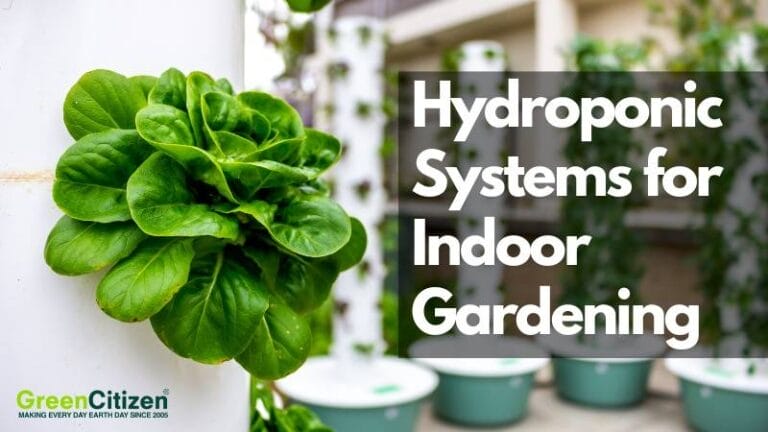I remember the first time I dipped my toes into hydroponics; I was clueless but excited. The idea of growing fresh veggies right in my living room without soil was fascinating.
Like many beginners, I was overwhelmed by the choices and technical jargon. But with a bit of research, I found the best hydroponic growing system for my needs, and it changed my gardening game forever.
Hydroponics is perfect for those who want to enjoy home-grown vegetables without the mess of traditional gardening. Whether you’re a seasoned gardener or a newbie, finding the right system can make all the difference. In this guide, I’ll walk you through top-rated hydroponic systems, helping you choose the best one for your green thumb.
Let’s explore the world of soilless gardening and discover the best hydroponic systems for transforming your vegetable garden.
5 Hydroponic System Brands Leading the Green Growing Revolution
1. AeroGarden: Making Indoor Gardening Effortless and Eco-Friendly
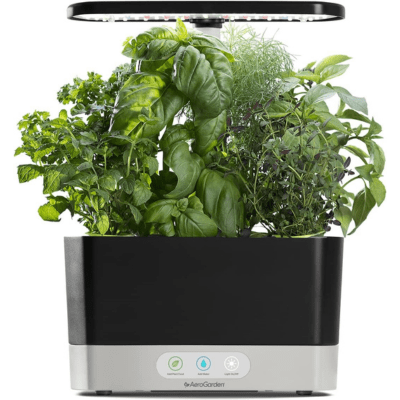
AeroGarden has long positioned itself as a leader in countertop hydroponics, but what makes it stand out in a sustainability-focused world is how seamlessly it brings green living into even the smallest apartments and busiest lifestyles.
At its core, AeroGarden’s mission is about accessible, soil-free growing — empowering everyday consumers to grow fresh herbs, leafy greens, and veggies right at home. This reduces reliance on commercially farmed produce, which often involves massive carbon footprints from transportation, packaging, and pesticide-heavy agriculture.
AeroGarden’s sustainability strengths lie in its low-water-use hydroponic design, energy-efficient LED grow lights, and commitment to non-GMO seed pods. The brand advocates fresh food with less waste, promoting localized, self-sufficient food production. Their systems recycle water and nutrients internally, drastically reducing water usage compared to traditional gardening.
On the manufacturing side, AeroGarden has taken steps to reduce plastic use in packaging and product design. While their systems are built from durable materials, they also encourage reuse of seed pod holders and accessories, minimizing single-use components.
From a lifestyle perspective, AeroGarden promotes year-round food cultivation — cutting down seasonal produce imports and encouraging a healthier, more eco-aware diet. For sustainability-minded gardeners, AeroGarden isn’t just a product — it’s a philosophy: grow what you need, where you live, with less waste and more joy.
2. Gardyn: Smart Gardening Meets Regenerative Living
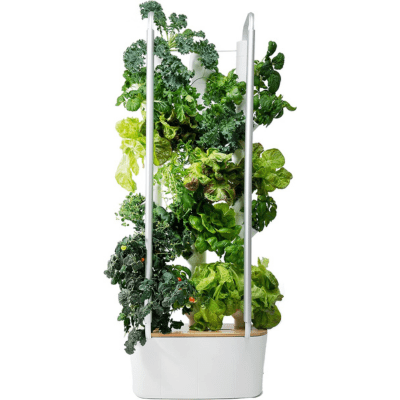
Gardyn isn’t just innovating hydroponics — it’s reimagining what sustainable homegrown food should look like. With their AI-powered indoor gardening systems, Gardyn combines cutting-edge tech with a deep-rooted commitment to environmental stewardship.
The brand’s philosophy is built around regenerative living. By empowering people to grow their own produce indoors, Gardyn directly reduces dependency on industrial agriculture — a major contributor to deforestation, pesticide runoff, and emissions from long-haul food transport. Every Gardyn unit enables users to grow fresh veggies, herbs, and even fruits using 95% less water than traditional gardening.
But where Gardyn really shines is in its closed-loop design. Their vertical systems are made for efficiency: using smart sensors, adaptive lighting, and app-based monitoring to minimize energy waste while maximizing yield. They also emphasize reusability — encouraging customers to reuse accessories and offering eco-conscious replacement parts when needed.
Gardyn’s Hybriponic™ technology (a hybrid of hydroponics and aeroponics) further boosts its sustainability game. It ensures optimal nutrient use while keeping water and energy consumption ultra-low. Plus, all their yCubes (seed pods) are non-GMO, pesticide-free, and compostable, reducing synthetic chemical exposure and landfill waste.
Gardyn is more than an indoor garden — it’s a movement toward reclaiming food sovereignty, even in urban apartments. For conscious consumers, it represents a future where smart tech and sustainability grow together.
3. Hey Abby: Minimalist Growing with a Maximalist Sustainability Ethos

Hey Abby may look sleek and simple on the outside, but behind its minimalist design lies a bold commitment to sustainable indoor farming. Created with urban gardeners in mind, Hey Abby redefines how we grow food indoors — with less mess, less waste, and more control.
At the heart of Hey Abby’s brand is closed-environment, low-impact cultivation. Their all-in-one growing cabinets use advanced hydroponic technology that slashes water use by up to 90% compared to soil farming. The system recycles water and nutrients continuously, making it one of the most eco-efficient setups for city living.
Hey Abby also shines when it comes to energy efficiency. The system is built with optimized LED lighting that mimics natural sunlight while consuming minimal power. Plus, the smart app helps users monitor and tweak settings to avoid overuse — saving resources while boosting yield.
Sustainability isn’t just in the tech. Hey Abby’s design promotes reusability: plant baskets, filters, and core components are made to last. They also support soil-free growing, eliminating the need for synthetic fertilizers or chemical-laden grow mediums.
And perhaps best of all, Hey Abby makes it cool to grow sustainably. With its quiet, enclosed design and sleek look, it fits into modern eco-lifestyles without screaming “gardener.” It’s for the mindful minimalist — someone who wants fresh food, less waste, and zero compromise on design.
4. Vivosun: Industrial Strength Meets Eco-Minded Cultivation
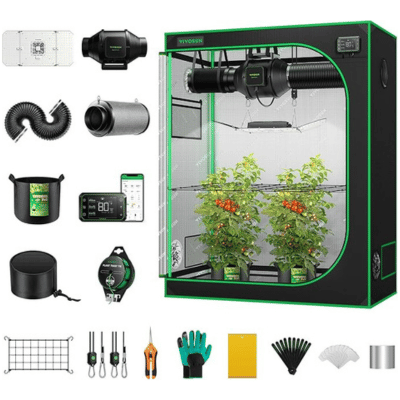
Vivosun is a powerhouse in the hydroponics and indoor growing world — but beneath that tough, utility-first exterior is a surprisingly thoughtful brand committed to sustainable cultivation at scale.
Known for serving everyone from hobbyists to commercial growers, Vivosun’s approach centers around durability, modularity, and eco-efficiency. Their hydroponic systems, grow tents, and tools are built to last — which means fewer replacements, less waste, and lower long-term environmental impact. Think: buy once, grow forever.
One of Vivosun’s biggest sustainability strengths is its integrated smart systems. Their GrowHub ecosystem helps users precisely manage light, water, temperature, and airflow — avoiding overuse of energy and nutrients. It’s tech that’s not just smart, but intentionally sustainable.
Vivosun also emphasizes non-toxic materials and energy-efficient LEDs, aiming to minimize synthetic inputs while maximizing crop quality. Their tools support both hydroponic and soil-free growing methods, offering a cleaner, more water-conscious alternative to outdoor gardening.
On the product manufacturing side, the brand is taking steps to reduce packaging waste and integrate recyclable components. Vivosun is clearly leaning into the idea that scalability doesn’t have to sacrifice sustainability — a major plus for growers who want eco-friendly tools without compromising on performance.
For those looking to expand their green thumb while shrinking their footprint, Vivosun is the go-to for serious sustainable growing.
5. Ingarden: Elegant Microgreens with a Micro Footprint
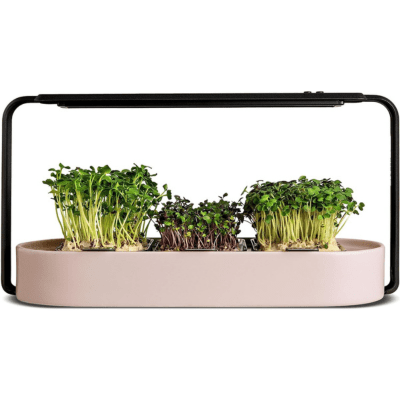
Ingarden may be the most stylish kid on the hydroponic block — but don’t let the aesthetic fool you. Beneath the ceramic beauty is a brand obsessed with sustainability, nutrition, and zero-waste living.
Designed specifically for growing microgreens, Ingarden offers a passive hydroponic system that needs no electricity, no soil, and almost no maintenance. That’s right — no wires, no noise, just pure, planet-friendly produce. This low-tech approach makes it one of the most resource-efficient indoor gardening options available today.
But Ingarden’s sustainability commitment doesn’t stop at the product — it’s baked into the brand DNA. Their trays are made from biodegradable, compostable fibers, and even the microgreen seed pads are organic, non-GMO, and plastic-free. Packaging? Minimal and fully recyclable. Everything is designed to leave a lighter footprint.
What really sets Ingarden apart is its emphasis on food as wellness and climate action. Microgreens grown at home eliminate the need for refrigerated transport, plastic clamshell packaging, and chemically treated produce. You’re literally growing your own superfoods while cutting down food miles and packaging waste.
Ingarden is the perfect match for conscious consumers who want to nourish their bodies and the planet — all while making their kitchen counter look like a wellness magazine spread.
Buying Considerations When Choosing a Hydroponic System
Starting your hydroponic journey can be exciting yet overwhelming. When I first ventured into hydroponics, I had no clue where to begin.
The options seemed endless.
But fear not! By considering a few key factors, you’ll find the best hydroponic system for your needs. Look at things like space, plant types, and budget. These will guide you to the right choice.
Remember, even small setups can yield big results.
So, take a deep breath, and let’s dive into the world of hydroponics together!
Types of Hydroponic Systems
When I first dipped my toes into hydroponics, I was blown away by the variety of systems. Each type has its own strengths and is suited to different needs.
Let’s explore the six common types of hydroponic systems and discover which might be the best hydroponic system for you.
Deep Water Culture (DWC) Systems
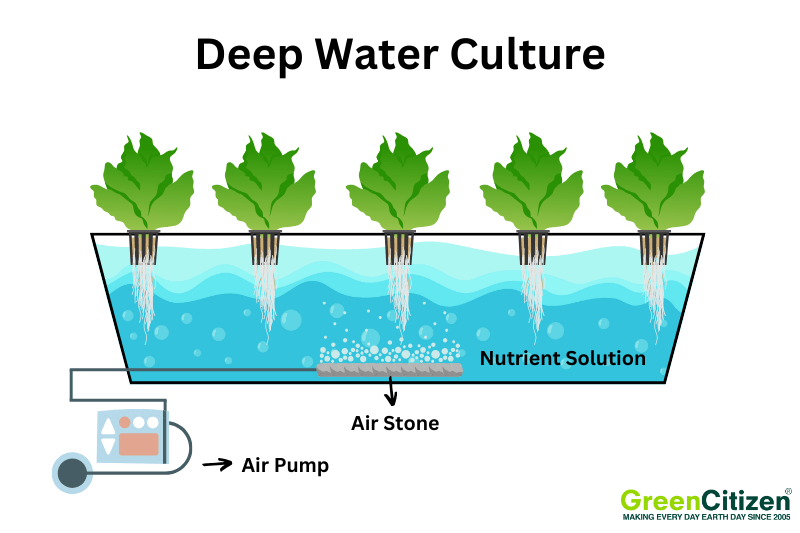
Deep Water Culture (DWC) is a popular choice for home gardeners. In DWC systems, plants are grown in containers, often called pods, with their roots submerged in nutrient-rich water.
A small pump circulates nutrients and oxygen, keeping the plants happy and healthy.
When I tried DWC, my herbs grew lush and vibrant, thanks to the continuous supply of nutrients and oxygen.
It’s a straightforward system that’s perfect for beginners.
Ebb and Flow Systems
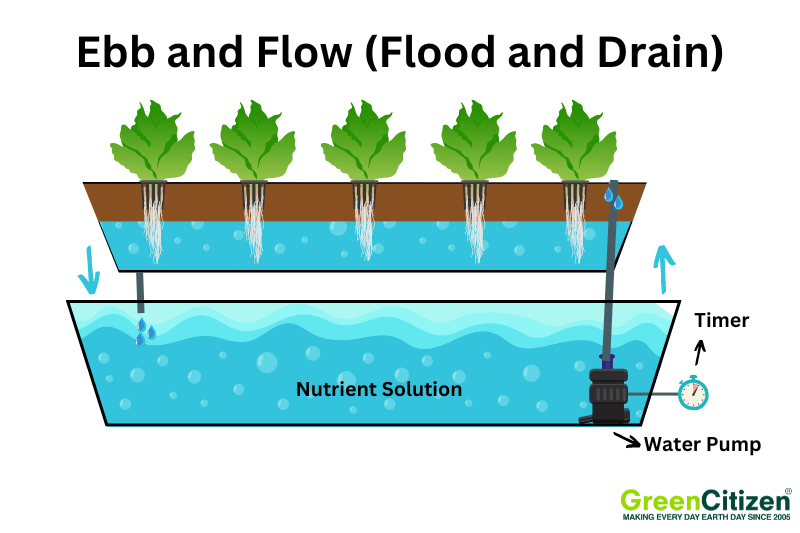
Ebb and Flow systems, also known as flood-and-drain, mimics natural watering cycles. This system floods the plant roots with nutrient-rich water and then drains it away. Controlled by a small pump, this cycle repeats every few hours.
I loved using Ebb and Flow for my lettuce plants.
They thrived with the periodic nutrient boosts and the system’s efficient water recirculation. It’s a great option if you’re mindful of water conservation.
Wicking Systems
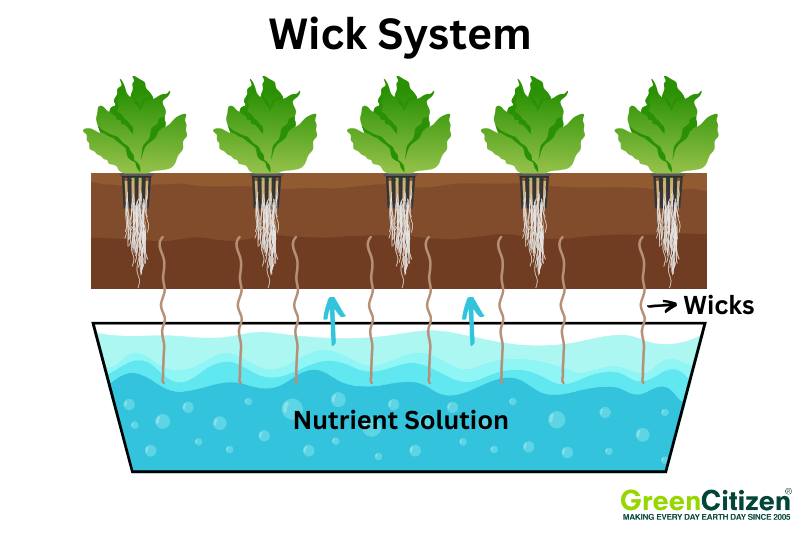
Wicking, or passive hydroponics, is as simple as it gets. This method uses an absorbent material, like a natural fiber rope, to draw water from a reservoir to the plant’s roots.
When I first started with wicking, I used perlite and a short piece of rope. It worked wonders for my microgreens.
This system is perfect for small plants and requires minimal maintenance, making it ideal for beginners.
Aeroponic Systems
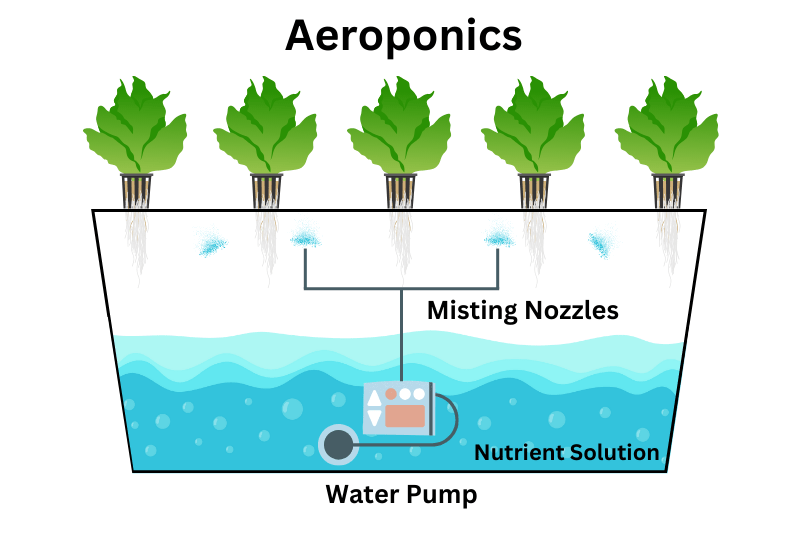
Aeroponic systems are a bit more advanced but highly efficient. In this setup, plant roots are suspended in the air and misted with nutrient-rich water.
I was fascinated by how quickly my plants grew using aeroponics. This is the ideal approach for those who are planning to setup a vertical garden in their homes.
The continuous misting provided an optimal environment for root growth. Although it requires more maintenance, the results are impressive. This method is perfect for gardeners looking for a high-tech approach.
Nutrient Film Technique (NFT) Systems
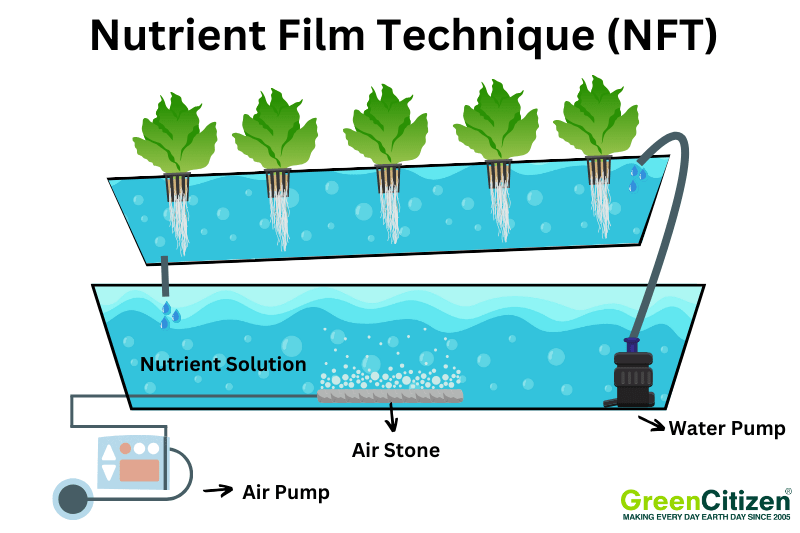
The Nutrient Film Technique (NFT) involves placing plants in channels where a thin film of nutrient-rich water flows over the roots. This method is highly efficient and often used in commercial setups.
I experimented with a smaller NFT system at home, which worked wonders for my leafy greens. The continuous nutrient flow ensured rapid and healthy growth. It’s a great choice for those wanting a more sophisticated system.
Drip Systems
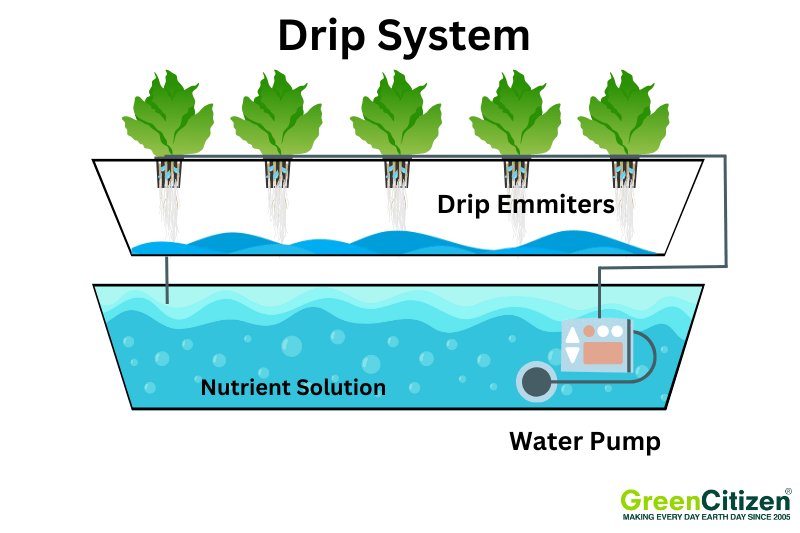
Drip hydroponics involves tubing with small drip nozzles above each plant. Water circulates through the tubing, dripping onto the plants and then draining back to the reservoir.
This method is common in commercial settings but can be adapted for home use.
Setting up a drip system was a bit complex, but it was highly effective for larger plants. The constant dripping provided consistent moisture and nutrients.
Each hydroponic system has its unique advantages. For beginners, wicking and DWC systems are simple and low-maintenance. More experienced gardeners might enjoy the advanced techniques of aeroponics or NFT systems.
Choose According to Your Experience Level
Choosing the best hydroponic system depends largely on your experience level. When I first started, I learned to sprout seeds, recognize when plants need food, monitor water flow, and adjust nutrient levels and pH.
Luckily, today’s hydroponic systems make indoor gardening easier than ever. Popular systems like AeroGarden come with mesh pods and soilless mediums, often coconut coir plugs. They also include pumps to circulate water and keep roots happy and hydrated.
Unlike old-school options, most modern indoor garden systems have grow lights on timers, ensuring your plants get the perfect amount of light for thriving growth.
Available Space
When choosing the best hydroponic system, consider your available space. If you live in a small apartment or have limited room, compact systems like wicking or Deep Water Culture (DWC) are perfect. They fit easily on countertops or shelves without hogging space.
For those with a bit more room, Ebb and Flow or Nutrient Film Technique (NFT) systems offer larger setups that can handle more plants. I found my NFT system a great fit for my kitchen corner.
If you have a spacious area, like a basement or large balcony, aeroponic or drip systems can maximize your growing potential. These setups can accommodate larger plants and provide higher yields.
If space is not a big concern for you, you can also try hydroponics greenhouse systems. These work perfect for larger spaces.
Types of Plants Can You Grow on a Hydroponic System
Hydroponic systems offer a versatile and efficient way to grow a wide variety of plants. When I first started with hydroponics, I was amazed at the diversity of plants I could cultivate.
- Leafy Greens: Lettuce, spinach, and kale thrive in hydroponic systems. These fast-growing plants are perfect for beginners and provide a continuous harvest.
- Herbs: Basil, mint, parsley, and cilantro are great choices. I love having fresh herbs at my fingertips for cooking.
- Vegetables: You can grow tomatoes, cucumbers, and bell peppers. These might require a bit more space and support, but the results are worth it. I once grew a tomato plant that produced juicy, delicious fruits right in my kitchen.
- Fruits: Strawberries do exceptionally well in hydroponic systems. Imagine plucking fresh strawberries from your indoor garden!
- Flowers: Yes, you can even grow flowers! Marigolds, petunias, and violets add a splash of color and cheer to your hydroponic setup.
How to Care for Plants in a Hydroponic System
Taking care of plants in a hydroponic system is simpler than you might think.
When I first started, I was amazed at how easy it was to keep my plants healthy and thriving. Here’s a beginner-friendly guide to get you started.
Monitor Water Levels: Always ensure your plants have enough water. The water should cover the roots but not drown them. Check the water level daily, especially during hot weather.
Nutrient Solution: Use a high-quality nutrient solution tailored for hydroponic systems. Follow the manufacturer’s instructions for mixing. I like to check the nutrient levels weekly to ensure my plants get the right amount of food.
pH Levels: Keep the pH level between 5.5 and 6.5. This is crucial for nutrient absorption. I use a simple pH testing kit to monitor and adjust the pH as needed.
Lighting: Provide adequate light. If you’re using grow lights, set them on a timer for about 12-16 hours a day. Natural sunlight works too, but ensure your plants get consistent exposure.
Air Circulation: Good air circulation prevents mold and disease. If your setup is indoors, consider using a small fan. It’s like giving your plants a breath of fresh air.
Regular Cleaning: Clean your hydroponic system regularly. Algae and debris can build up, affecting plant health. I usually clean my system every two weeks to keep it in top shape.
Check for Pests: Even in a hydroponic setup, pests can appear. Inspect your plants regularly and use natural pest control methods if needed. Neem oil works great for me.
Pruning and Harvesting: Trim dead or yellowing leaves to encourage new growth. Harvest your plants regularly. This not only gives you fresh produce but also promotes continued growth.
Caring for your hydroponic plants might seem daunting at first, but with these simple steps, you’ll soon become a pro.
Why Should You Start Hydroponics Gardening?
Hydroponic gardening is a fun hobby and a sustainable way to grow your own food. When I started, I was amazed at how much I could grow in a small space, using less water than traditional gardening. It’s a win for both you and the planet.
So, why not give it a try? With the best hydroponic system, you can enjoy fresh, home-grown produce all year round.
Dive into the world of hydroponics and join the movement towards a greener, more sustainable future.
Happy gardening!
